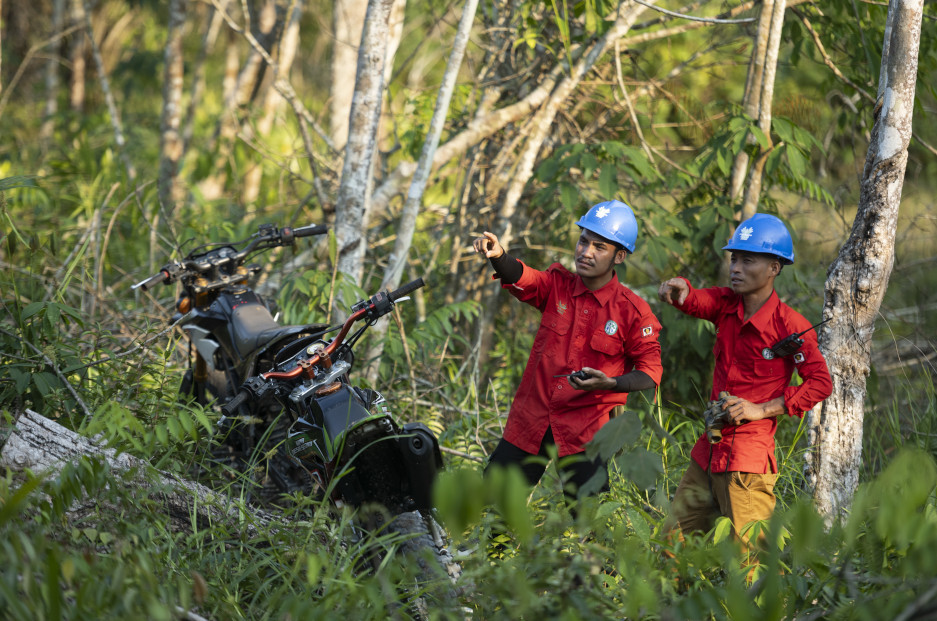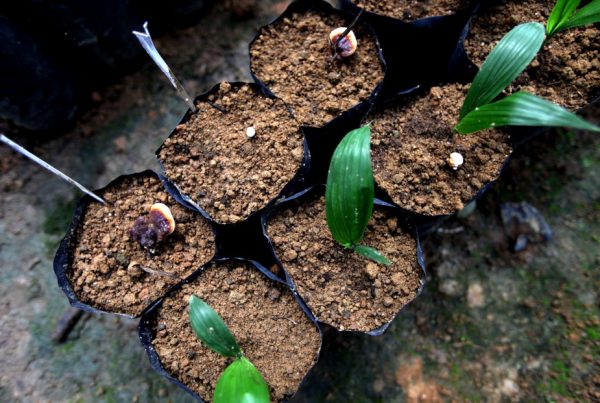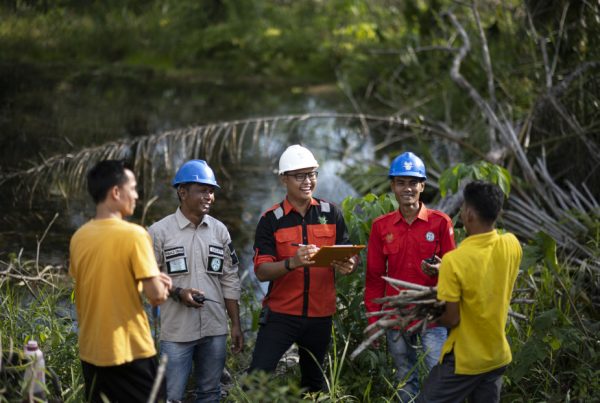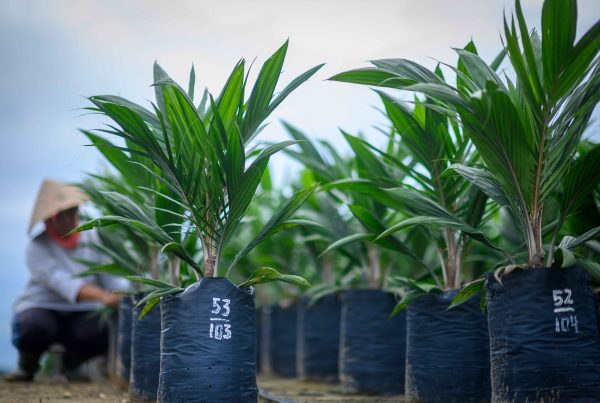Every dry season, thousands of hotspots appear across Indonesia, especially in Sumatra and Kalimantan’s peatlands and plantation areas. During El Niño years, these risks rise sharply as prolonged dry spells and delayed rainfall create ideal conditions for fires to start and spread. This makes early detection and strong prevention measures more critical than ever.
A hotspot is an area where ground temperatures spike, detected through satellite monitoring. Satellites can only capture areas where surface temperatures are unusually high. These spikes can happen for many reasons. Sometimes they are caused by sunlit roads, exposed brick walls, dry leaves, or even smoke from small cooking fires.
This is why hotspot data can be misleading if not verified carefully. At Asian Agri, we take a more thorough approach by ground-truthing every hotspot we detect. Our fire response teams visit each location to confirm whether there is an actual fire before taking further action or reporting the data. By doing this, we ensure our response is accurate, effective, and based on verified information rather than assumptions.
The importance of this approach becomes clear when looking at the bigger picture.
According to data from SiPongi, an online forest and land fire monitoring system by Indonesia’s Ministry of Forestry, a total of 376,805.05 hectares of forest and land burned across Indonesia in 2024. The figures show that East Kalimantan experienced the largest area of fire damage, followed by Riau and Aceh.
These fires produce dense smoke that fills the air, disrupts daily life, and damages community well-being both near and far. In serious cases, such as the 2015 haze crisis, smoke from forest and peatland fires in Indonesia drifted into neighboring countries, including Malaysia, Singapore, and parts of Thailand.
The impact was severe. Visibility fell below one kilometer, schools were forced to close, and cases of breathing problems increased sharply.
For Asian Agri, managing fire risk means more than safeguarding palm oil production. It means working closely with villages to prevent fires and protect the environment. The Fire-Free Village Program (FFVP) was established to empower communities to maintain their land as safe and fire-free as possible, even during challenging seasons.
The sections below examine:
- How El Niño increases fire risks across Indonesia’s peatlands and plantations
- How Asian Agri prepares for these extreme dry conditions through early detection, training, and year-round readiness
What is El Niño
El Niño is a natural climate pattern that originates in the Pacific Ocean and impacts weather worldwide. It happens when ocean temperatures near the equator rise by half a degree or more.
Even a small rise in temperature can disrupt weather patterns and raise the risk of drought in many places.
In Indonesia, El Niño often means less rain, a delayed start to the rainy season, and longer dry periods. These conditions make it easier for land and forest fires to start, especially in fire-prone areas like peatlands.
Because El Niño amplifies fire risks, Asian Agri strengthens its prevention efforts during these periods. That’s why taking early action is so important.
At Asian Agri, we work closely with local communities to stop fires before they start. Since El Niño’s impact can last for several months, our fire prevention strategy focuses on staying one step ahead, covering everything from early detection to rapid response and community preparedness.
Through programs like the Fire-Free Village Program (FFVP), we focus on building awareness, reducing risks, and supporting fire prevention efforts—especially during dry periods linked to El Niño.

Asian Agri’s fire team patrolling to monitor hotspots in surrounding operational areas.
Readiness Ahead of El Niño
At Asian Agri, fire prevention doesn’t start with smoke. It starts much earlier, as a year-round effort with preparation tailored to the heightened risks brought by El Niño.
Our fire teams stay active on the ground, monitoring weather patterns, identifying early warning signs, and collaborating closely with nearby communities. When El Niño is on the horizon, this work becomes even more important.
One of the first things the team looks for is the appearance of hotspots.
“Hotspots are one of the first signs we look for when assessing fire risk,” says Dani Nugraha Syafly, Fire Assistant at Asian Agri. “They help us detect unusual increases in ground temperature before any visible signs of fire appear. This early signal gives us a critical window to respond quickly and prevent fires from spreading.”
This fast response wouldn’t be possible without proper training. All new team members go through fire prevention and emergency response sessions at the Asian Agri Learning Institute (AALI).
In El Niño years, we hold extra refresher trainings to make sure our teams are ready for the increased fire risks and can move quickly alongside local fire authorities whenever action is needed.
Training is only one part of our year-round preparedness. In the months outside the dry season, teams focus on:
- Maintaining fire-prevention equipment,
- Monitoring high-risk areas that become drier during El Niño,
- and Carrying out outreach and education for farmers.
Together, this continuous cycle of training, equipment upkeep, monitoring, and community engagement means that when El Niño peaks, our teams work hand in hand with village partners and local fire authorities to respond quickly and prevent small hotspots from turning into major fires.
As Dani puts it, “We don’t wait for the fire season to act. Prevention starts long before the first hotspot appears.” Our teams are on the ground year-round, building relationships, raising awareness, and helping each village understand the risks. We’re not reactive; we’re proactive.
This approach becomes even more important during El Niño, when longer dry periods increase the risk of fires. Through the Fire-Free Village Program, Asian Agri works closely with local communities to prevent fires, provide training, and raise awareness.
These efforts help villages prepare for challenging seasons and manage fire risks more effectively. By giving communities the right tools and knowledge, the program makes it less likely for small hotspots to grow into major fires.
Want to know how it works on the ground?
Explore how the Fire-Free Village Program empowers villages with tools, training, and support to lead local fire prevention efforts. Learn more about the FFVP in action
Frequently Asked Questions (FAQ)
What is the Fire-Free Village Program (FFVP)?
The Fire-Free Village Program (FFVP) is Asian Agri’s community-based fire prevention initiative designed to stop land and forest fires before they start. Through training, fire prevention equipment, awareness campaigns, and performance-based incentives, the program empowers local residents to monitor risks, detect hotspots early, and respond quickly during dry seasons, including El Niño years.
Why does El Niño increase fire risk?
El Niño increases fire risks in Indonesia by causing hotter, drier weather, delayed rainfall, and longer dry seasons. These conditions dry out vegetation and peatlands, making it easier for even small sparks to grow into large-scale land and forest fires. During El Niño, Asian Agri strengthens its fire prevention strategy by enhancing hotspot monitoring, increasing training for fire teams, and working closely with local communities to prevent fires from spreading.
What is the importance of fire prevention in plantations and peatland areas?
Fire prevention is essential in plantations and peatlands to protect lives, property, biodiversity, and air quality while safeguarding palm oil crop yields and supporting sustainable production. In peatlands, prevention is especially urgent because dry peat is highly flammable and peat fires burn underground, making them extremely difficult to extinguish. Through the Fire-Free Village Program and year-round training, Asian Agri works closely with local communities to detect hotspots early and control fires before they grow.
What equipment is used for fire prevention and protection?
Asian Agri and local fire teams use specialized fire prevention and protection equipment to detect risks early and respond quickly. This includes:
- High-pressure water pumps for extinguishing fires
- Hoses and nozzles to distribute water effectively
- Personal protective gear to keep fire teams safe
- Communication tools like radios and GPS units for coordination
- Satellite-based hotspot monitoring systems to detect fire risks early
Read more about Asian Agri’s sustainability commitments




